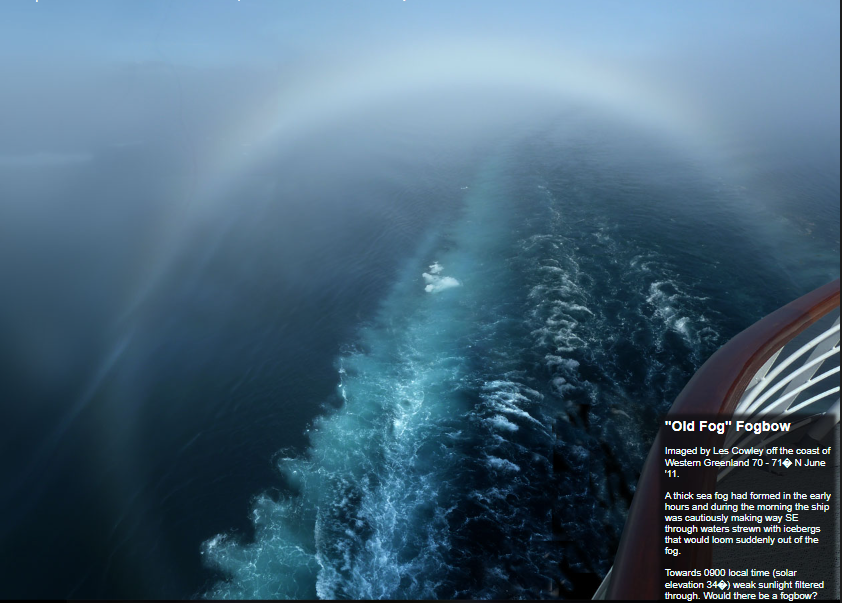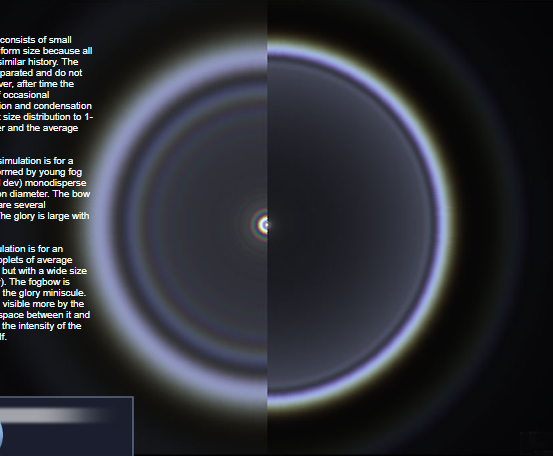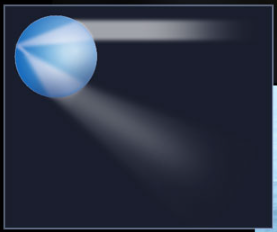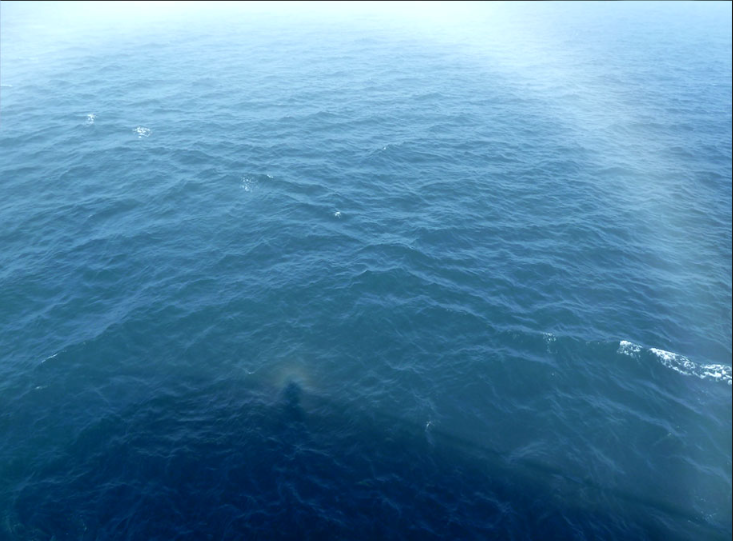OPOD - Old Fog Fogbow, Greenland
OPOD - Old Fog Fogbow, Greenland: A Delicate Phenomenon in the Arctic
The Arctic region is known for its stunning natural phenomena, and one such captivating sight is the "Old Fog" Fogbow. Imaged by Les Cowley off the coast of Western Greenland, this fogbow offers a mesmerizing display of light and mist. Let's delve deeper into this ethereal atmospheric optics phenomenon.
The Enigmatic Formation of the Old Fog Fogbow
In June '11, while navigating through the waters strewn with icebergs, a thick sea fog enveloped the area off the coast of Western Greenland. As weak sunlight filtered through the fog, the possibility of a fogbow emerged. The antisolar point, which is the center of a fogbow, was positioned over the stern rail. Gradually, an ethereal arc began to appear over the ship's wake as the fog thinned and sunlight strengthened.
The Radiant Colors and Subtle Details
The Old Fog Fogbow exhibited a distinctive red outer rim and a delicate blue inner rim, particularly in the lower section where it was viewed against the dark sea. Observers were occasionally treated to the glimpse of a weak single supernumerary, a faint additional arc that appears on the inner side of the primary arc. Moreover, around the shadow of Les Cowley's head on the sea, a weak single ringed glory appeared. As time passed, this glory strengthened, revealing its true glory.
Unveiling the Secrets of Old Fog
Freshly formed fog consists of small droplets that are fairly uniform in size. However, as time progresses, the combined effects of occasional collisions, evaporation, and condensation cause the droplet size distribution to broaden, resulting in larger droplets. This phenomenon explains why "old fog" produces such fascinating optical displays.
The Influence of Droplet Size on Fogbows and Glories
Comparisons with IRIS Mie-Lorentz simulations shed light on the droplet size distribution in the Old Fog Fogbow. These simulations indicated a median droplet diameter exceeding 40 microns, with a very wide size distribution. This data suggested that the fog droplets were considerably larger and had a broader range of sizes compared to freshly formed fog.
Fresh vs. Old Fogs: A Visual Comparison
To better understand the differences between fresh and old fogs, IRIS simulations were conducted. The left-hand simulation represented a fogbow and glory formed by young fog with almost monodisperse droplets of 16 microns in diameter. In this case, the bow appeared broad, and several supernumeraries were visible. On the other hand, the right-hand simulation depicted an evolved fog with droplets averaging 50 microns in diameter but with a wide size range. Here, the fogbow appeared much narrower, and the glory was minuscule, with a supernumerary barely discernible.
The Formation of Fogbows: A Play of Light and Water
Fogbows form in a manner similar to rainbows, through a single reflection of sunlight within spheres of water. However, unlike rainbows that form from raindrops with diameters of 1mm or more, fog droplets are significantly smaller. As a result, diffraction effects become significant, causing the fogbow to broaden considerably.
The Enigmatic Companion: The Diminutive Glory
Accompanying the Old Fog Fogbow is a diminutive glory. This optical phenomenon occurs when sunlight is backscattered by individual water droplets in the fog. The glory appears as concentric rings of colors surrounding the observer's shadow, creating a captivating spectacle.
In conclusion, the Old Fog Fogbow off the coast of Western Greenland presents a captivating interplay of light and mist. As we explore the intricate details of this atmospheric optics phenomenon, we discover the influence of droplet size on the appearance of fogbows and glories. Whether fresh or old, fog showcases its unique charm, enchanting observers with its ever-changing beauty. So, if you find yourself in the Arctic region, keep an eye out for the mesmerizing display of the Old Fog Fogbow.

"Old Fog" Fogbow
Imaged by Les Cowley off the coast of Western Greenland 70 - 71� N June '11.
A thick sea fog had formed in the early hours and during the morning the ship was cautiously making way SE through waters strewn with icebergs that would loom suddenly out of the fog.
Towards 0900 local time (solar elevation 34�) weak sunlight filtered through. Would there be a fogbow?
The antisolar point (a fogbow's centre) was down over the stern rail and sure enough arcing over ship�s wake was the first inkling of a fogbow which steadily became more definite as the fog thinned and the sunlight strengthened.
A red outer rim and a delicate blue inner one were evident particularly in the lower section where the bow was viewed against the dark sea. In that area a weak single supernumerary was occasionally glimpsed.
Around the shadow of my head on the sea was a weak single ringed glory which strengthened later on (lower image). The glory's small diameter, the fogbow colours, narrow width and indistinct supernumeraries together indicated that the fog droplets had a large median size with a substantial spread of actual diameters.
Old fog! Freshly formed fog has a narrower droplet size distribution and smaller droplets. Fresh fog gives the best fogbows and glories.
Subsequent comparison with IRIS Mie-Lorentz simulations indicated a median droplet diameter in excess of 40 micron with a very wide size distribution � old fog indeed.

Fresh & Old Fogs
Freshly formed fog consists of small droplets of fairly uniform size because all the droplets are of similar history. The droplets are well separated and do not often collide. However, after time the combined effects of occasional collisions, evaporation and condensation broaden the droplet size distribution to 1- 100 micron diameter and the average size gets larger.
The left hand IRIS simulation is for a fogbow and glory formed by young fog with almost (3% std dev) monodisperse droplets of 16 micron diameter. The bow is broad and there are several supernumeraries. The glory is large with several rings.
The right hand simulation is for an evolved fog with droplets of average diameter 50 micron but with a wide size range (35% std dev). The fogbow is much narrower and the glory miniscule. A supernumerary is visible more by the characteristic dark space between it and the primary than by the intensity of the supernumerary itself.

Fogbows form like rainbows by a single reflection of sunlight within spheres of water. Raindrops spheres are 1mm or more in diameter but those of fog are sufficiently small that diffraction effects become significant and the bow is considerably broadened.

The diminutive glory accompanying the 'old fog' fogbow.
Note: this article has been automatically converted from the old site and may not appear as intended. You can find the original article here.
Reference Atmospheric Optics
If you use any of the definitions, information, or data presented on Atmospheric Optics, please copy the link or reference below to properly credit us as the reference source. Thank you!
-
<a href="https://atoptics.co.uk/blog/opod-old-fog-fogbow-greenland/">OPOD - Old Fog Fogbow, Greenland</a>
-
"OPOD - Old Fog Fogbow, Greenland". Atmospheric Optics. Accessed on April 20, 2024. https://atoptics.co.uk/blog/opod-old-fog-fogbow-greenland/.
-
"OPOD - Old Fog Fogbow, Greenland". Atmospheric Optics, https://atoptics.co.uk/blog/opod-old-fog-fogbow-greenland/. Accessed 20 April, 2024
-
OPOD - Old Fog Fogbow, Greenland. Atmospheric Optics. Retrieved from https://atoptics.co.uk/blog/opod-old-fog-fogbow-greenland/.